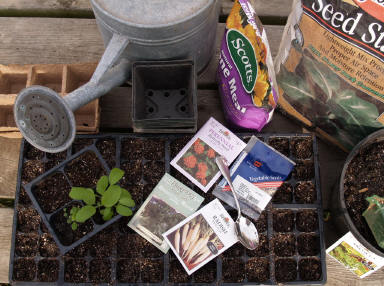Audrey Cooke
Frederick County Master Gardener
 The techniques and materials involved in starting seeds are simple and few. Starting plants from seed has practical benefits: saving money; getting a head start on the
growing season; and choosing from varieties beyond those locally available. There is also the magical benefit: the sheer joy and wonder of watching a lifeless seed sprout into a living plant.
The techniques and materials involved in starting seeds are simple and few. Starting plants from seed has practical benefits: saving money; getting a head start on the
growing season; and choosing from varieties beyond those locally available. There is also the magical benefit: the sheer joy and wonder of watching a lifeless seed sprout into a living plant.
Knowing when to start seeds indoors takes some backward thinking. Find out the average date of the last frost in your area and the number of weeks before that date you should start a particular seed (the number of weeks varies and is listed on the
seed package). Then count backwards on the calendar from the average last frost date. Most seeds should be started six to eight weeks before the last frost date. Some seeds can be started a few weeks before it, while others may need a lead-time of 12 to 14 weeks. If you
start seeds too early, you will have to keep the seedlings inside too long, and they will be weak by transplant time.
For successful seed starting, it is vital to start with healthy seed. Buy packets of fresh seed from a catalog or your local garden center. Look for the phrase, "Packed for . . …" somewhere on the packet; for best results the date should be the
current year. Packets from mail order catalogs may not be dated. Be sure to write the year of the purchase on these packets for future reference. Easy seeds for beginners include marigolds, zinnias, sunflowers, coleus, nasturtiums and cosmos.
Buy a commercial seed starting mix, or make your own with equal parts of vermiculite, milled sphagnum moss, and perlite. Put the mix in a plastic bucket or basin, add a bit of warm water and stir. Keep adding water until the mix is evenly moist.
Squeeze a handful lightly-only a few drops of water should ooze out. If the mix is too wet, add more dry mix.
Containers for seed starting should be 2 ½ - 3 inches tall. Use commercial seed starting containers or recycled household items like milk cartons, yogurt cups, or aluminum pans. Whatever you choose be sure to punch holes in the bottom for drainage.
To plant your seeds, fill your containers to the top with the moist mix. Tap on a hard service to settle it a bit. Scatter small seeds evenly over the surface. If the seed should be covered (according to the seed packet), gently press seeds into the
mix and scatter a little mix over the seed. Use the flat of your fingertips to lightly press the mix down and level it. For larger seeds use a pencil eraser to push the seed down to the desired depth. Many seedlings look alike, so be sure to label. Frozen dessert sticks are
ideal.
Watering: Keep the moisture level moist during germination, as well as after germination and during the growing phase. Never soak your seeds or seedlings. Seeds that are kept too wet or too dry may fail to grow.
Temperature: The recommended soil temperature range for most seeds started indoors is 75 degrees F to 90 degrees F. If room temperature is about 70 degrees F, you may need to place containers in a warm spot, such as near a kitchen stove, heat vent,
or on top of the refrigerator. A seedling heat mat is ideal. Seedling heat mats are relatively inexpensive and can be purchased from garden centers or catalogs. After germination, slightly cooler temperatures will slow down growth and result in stockier plants. Seedlings
kept too warm will grow too fast and get weak and leggy.
Light: Light levels are critical. Most seed do not need light to germinate, but as soon as they sprout, they need to be in a south facing window. Most seedlings need 12-14 hours of direct light.
As seedlings develop their first set of true leaves (after the initial seed leaves), the containers will become crowded and you will need to thin them. Keep the largest healthiest plants and pull out the unwanted plants or cut off their stems at soil
level, leaving at least an inch of space between the remaining seedlings.
Since soilless mixes may contain no nutrients start feeding seedlings with half strength liquid fertilizer. You may need to transplant your seedlings into larger pots if they start to get crowded and it is still too early to plant them outdoors. At
least one week before planting in the garden, place the plants outdoors for an hour or two each day in a protected spot to "harden/acclimate" the plants. Gradually increase the time that they spend outdoors, but be sure to protect the plants from too much wind and hot sun.
Check the moisture level of the plants at least once daily to make sure they do not dry out too quickly while adjusting to the outdoors. Finally, try to transplant the new plants to the garden on a cloudy day to minimize transplant shock.
Read other articles on house plants
Read other spring related gardening articles